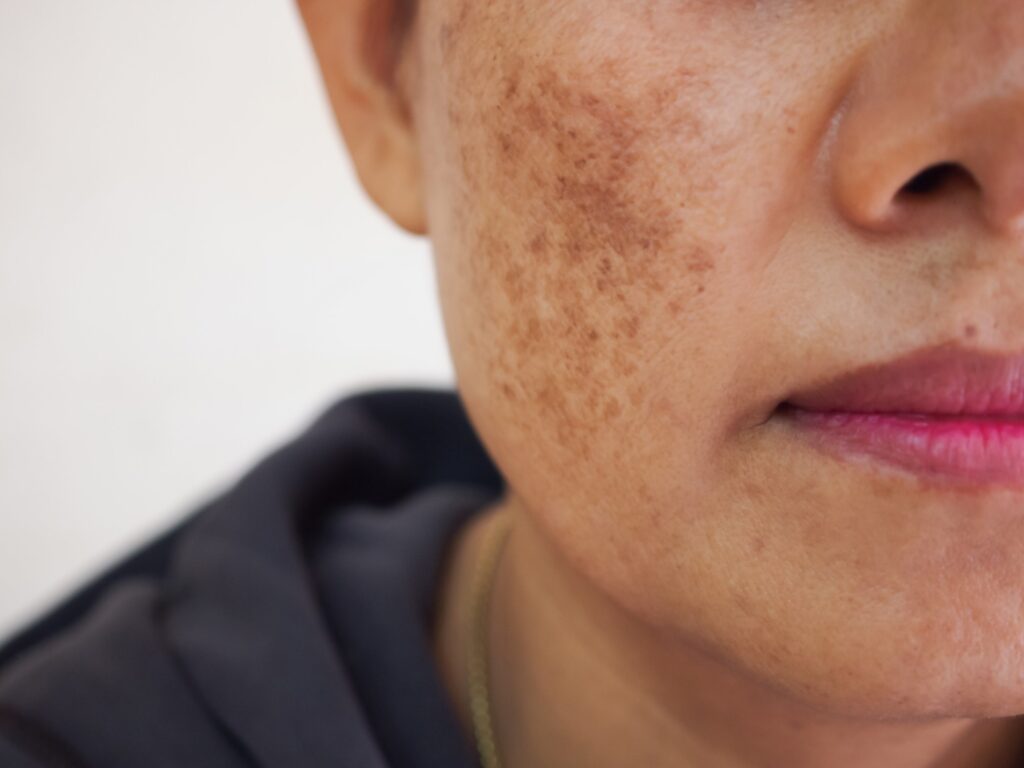Pigment Disorders
What is melasma?
Melasma is a common condition that affects mostly females and those with darker complexions. This condition can appear as brown/grey spots on the face, and even on the neck, chest or forearm.
Continue reading to learn more about pigment disorders.
Can you prevent melasma?
There are many steps you can take to prevent melasma, such as:
- Avoiding the sun
- Wearing sunscreen
- Discontinuing triggers such as birth control

How is melasma treated?
There are many types of treatments for melasma, including:
Topical option:
- Hydroquinone: This topical cream that comes in different concentrations is a common cream used to help lighten the skin.
- Tretinoin: This topical cream is typically used with hydroquinone and is used to help lighten the skin.
- Kojic acid is often included in formulations to inhibit enzymes involved in making pigment.
- Retinoic acid
- Ascorbic acid (vitamin C) also inhibits pigment production but is highly unstable, so is best combined with other agents.
- Azelaic acid: This topical cream can be used for those who are pregnant.
- Many other topical agents, including arbutin and resorcinol.
In-Office Procedures:
- Chemical peel
- Microdermabrasion
- Microneedling
- Laser treatment
- Photodynamic therapy
What are the outcomes for those with melasma?
Treating melasma can be challenging, and it may take a couple of months for an individual to see an improvement on the skin. Please remember, if your skin condition clears, you will still need to continue treating the area.
What is vitiligo?
Vitiligo is a skin disorder affecting those mostly aged 30, which causes loss of color in the skin by affecting cells that produce pigment (melanin) in patches, which can increase in size over time.
There are many types of vitiligo, including:
- Universal vitiligo: Loss of skin color all over the skin
- Generalized vitiligo: Loss of color in a symmetrical pattern on the body
- Segmental vitiligo: Loss of color on one side of the body
- Focal vitiligo: Loss of color in a couple of areas on the body
- Acrofacial vitiligo: Loss of color on the hands and face
While treatment can help bring color back to the affected area, it doesn’t prevent the loss of skin color in the future.
What are the symptoms of vitiligo?
The three most common symptoms of vitiligo include:
- Patchy loss of skin color: Typically, the loss of skin color will appear on the hands, face or openings of the body
- Hair color change: Premature whitening or graying of an individual’s hair on the scalp, eyelashes, eyebrows or beard
- Loss of color in an individual’s mouth and nose
What causes vitiligo?
Three common factors that cause vitiligo include:
- Autoimmune disorders such as Addison’s disease, lupus and diabetes
- Hereditary
- Triggers such as stress, sunburns or trauma to the skin
How is vitiligo diagnosed?
To diagnose vitiligo, you will need an exam that includes a skin biopsy and laboratory tests.
How is vitiligo treated?
Unfortunately, medications can not stop vitiligo. As mentioned, some medications and light therapy can help restore color to the skin, but can not stop future progression.
Some of the medication treatments listed below can cause serious side effects. Your doctor may suggest self-tanning or makeup products prior to prescribing medication.
Medications:
- Steroids: Steroid cream can help return color, but is typically effective in the early stages of vitiligo. You may not see improvement in the skin for many months and may notice your skin thinning.
- Calcineurin inhibitor ointments: Ointments such as Protopic and Elidel may be effective for areas like the face or neck.
Therapies:
- Light therapy
- Removing remaining color: For those who have lost large portions of color in their skin, it may be recommended to apply a bleaching medication to other areas so that the skin tone can be evened.
Surgery:
- For those whose vitiligo is stable, skin grafts can be applied to the affected areas
Currently, research is being done for other treatment options.
What are the outcomes for those with vitiligo?
Due to this varying skin condition, treatment results can’t be predicted. Further, outcomes can vary from body part to body part.
How can my dermatologist help?
At the Dermatology Center for Skin Health, PLLC, we offer many cosmetic procedures that can be integrated into your treatment.
Our staff is dedicated to keeping up-to-date with the most advanced procedures and patient education. If you are experiencing a pigment disorder and would like a consultation, please contact us.
Dermatology Center for Skin Health, PLLC
600 Suncrest Towne Centre, Suite 115
Morgantown, WV 26505
Our office is located on the ground floor of the 600 Suncrest Towne Centre Building. Please enter through the middle doors at the front of the building. The Dermatology Center for Skin Health, PLLC entrance is located just inside the building — first door on the right.
You can also text us to make an appointment.
To communicate with us from a mobile phone, click the button below or send a text to the number.

